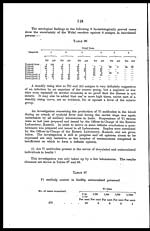Medicine - Institutions > Army health reports and medical documents > Annual report on the health of the army in India > Volume II [2], Part I - Annual report on the health of the army in India for the year 1939
(319) Page 117
Download files
Individual page:
Thumbnail gallery: Grid view | List view

117
Serum and C. S. F. from a case of sandfly fever collected on the 1st and
2nd day of the disease respectively were tested for the presence of virus. It
was found to be present in both as judged by lesions obtained on egg mem-
branes.
65. PATHOLOGY.
The routine work again showed an annual increase during 1939. A
total of 2,36,528 specimens were sent for laboratory examination during
the year, 14,744 more than last year. This annual increase which has now
taken place for some years past is considered to be due to the following three
main factors:—
(a ) A greater appreciation by medical officers of the value of labora-
tory reports as an aid to clinical diagnosis, with the result that
more specimens are sent from the wards to the laboratory for
examination.
(b ) A greater realization by all of the importance of the control of water
and milk purification by laboratory tests.
(c ) A greater ability, as the result of steadily improving equipment
on the part of laboratories to undertake the more complicated
investigations.
A larger number of examinations was also carried out in clinical side
rooms of hospitals in connection with malaria, dysentery cases and chemical
examinations of urine, etc. In the reports for the past two years it was point-
ed out that a considerable number of examinations at present carried out in
laboratories could be done equally well in clinical side rooms if their equip-
ment was slightly increased. Owing to the present war however this matter
has been temporarily dropped.
Enteric Group of Fevers and Salmonella infections. —Repeated Widal
tests were carried out on "bacteriologically undiagnosed" so called enteric
group cases. A total of 42 cases were diagnosed "group" infection through-
out the year which represented 19 British and 23 Indian. Of these, 18 were
serologically negative and were diagnosed on clinical grounds only. The great
majority of cases as noted last year were mild in type with few symptoms
other than pyrexia and a slow pulse. The average pyrexial period for the
above cases was 15 days. In last year's report it was pointed out that the
diagnosis of enteric group in the absence of definite serological findings was too
readily made. The same remark applies to the year under review and clini-
cians still seem to shrink from the term P. U. O., and are apparently most
anxious to avoid the stigma which is fancied by some to adhere to this con-
clusion which is scientific provided the case has been thoroughly investigated
and all bacteriological evidence etc., is negative. In this case P. U. O. or pyrexia
of unknown origin is a perfectly sound diagnosis. In this connection it is
pointed out however that the results of Widal tests carried out on these cases
is not one hundred per cent efficient, and in some cases results obtained in
inoculated individuals are of small value.
In carrying out the above tests TO and AO suspensions supplied by the
Enteric Laboratory, Kasauli, were universally employed by Military Labora-
tories.
Set display mode to: Large image | Zoom image | Transcription
Images and transcriptions on this page, including medium image downloads, may be used under the Creative Commons Attribution 4.0 International Licence unless otherwise stated. ![]()
| Permanent URL | https://digital.nls.uk/74988062 |
|---|




